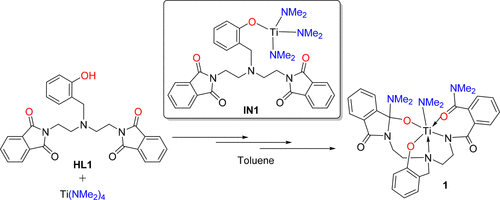当前位置:
X-MOL 学术
›
Inorg. Chem.
›
论文详情
Our official English website, www.x-mol.net, welcomes your feedback! (Note: you will need to create a separate account there.)
Synthesis of Titanium Complexes Supported by Carbinolamide- and Amide-Containing Ligands Derived from Ti(NMe2)4-Mediated Selective Amidations of Carbonyl Groups.
Inorganic Chemistry ( IF 4.6 ) Pub Date : 2020-09-21 , DOI: 10.1021/acs.inorgchem.0c01831 Shengwang Xia 1 , Zhilei Jiang 1 , Yuan Huang 1 , Dawei Li 1 , Yanfeng Cui 1 , Yahong Li 1 , Yuanzhi Xia 2
Inorganic Chemistry ( IF 4.6 ) Pub Date : 2020-09-21 , DOI: 10.1021/acs.inorgchem.0c01831 Shengwang Xia 1 , Zhilei Jiang 1 , Yuan Huang 1 , Dawei Li 1 , Yanfeng Cui 1 , Yahong Li 1 , Yuanzhi Xia 2
Affiliation

|
An efficient strategy for the syntheses of a series of titanium complexes has been developed. This protocol features the employment of Ti(NMe2)4 both as the metal center to trigger the deprotonation of the ligands and as an amine source to proceed the amidation reactions of carbonyl functionalities of the ligands. Treatment of Ti(NMe2)4 with a ligand HL1 (HL1 = 2,2′-(((2-hydroxybenzyl)azanediyl)bis(ethane-2,1-diyl))bis(isoindoline-1,3-dione) results in the formation of Ti(L1′)(NMe2) (1) (H3L1′ = N1-(2-((2-(1-(dimethylamino)-1-hydroxy-3-oxoisoindolin-2-yl)ethyl)(2-hydroxybenzyl)amino)ethyl)-N2,N2-dimethylphthalamide). One important feature regarding the synthesis of 1 is the occurrence of the in situ metal–ligand reaction between Ti(NMe2)4 and HL1, leading to the simultaneous formations of carbinolamide and amide scaffolds. Another prominent feature in terms of the preparation of 1 is the achievement of the selective ring-opening reaction of one of the two phthalimide units of the HL1 ligand, affording carbinolamide and amide functionalities within one ligand set. The developed methodology characterizes an ample substrate scope. The selective amidation reactions of the carbonyl groups have been realized for a series of analogous ligands HL2–HL7. Density functional theory calculations were employed to disclose the mechanisms for the formation of 1–7, and the details for the selective ring-opening reactions of the phthalimide unit were uncovered.
中文翻译:

由Ti(NMe2)4介导的羰基选择性酰胺化衍生的含羧酰胺和酰胺的配体支持的钛配合物的合成。
已经开发了用于合成一系列钛配合物的有效策略。该协议的特点是采用Ti(NMe 2)4作为金属中心引发配体的去质子化,并作为胺源进行配体羰基官能团的酰胺化反应。用配体HL1(HL1 = 2,2'-((((2-羟基苄基)氮杂二基)双(乙烷-2,1-二基))双(异吲哚啉-1,3-二酮)处理Ti(NMe 2)4导致形成Ti(L1')(NMe 2)(1)(H 3L1'= N1-(2-(((2-(1-(二甲基氨基)-1-羟基-3-氧代异吲哚-2-基)乙基)(2-羟基苄基)氨基)乙基)-N2,N2-二甲基邻苯二甲酰胺)。关于合成1的一个重要特征是Ti(NMe 2)4与HL1之间发生了原位金属-配体反应,导致同时形成了羧酰胺和酰胺骨架。在准备1方面的另一个突出特点是实现HL1配体的两个邻苯二甲酰亚胺单元之一的选择性开环反应的实现,在一个配体组中提供了甲酰胺和酰胺官能团。所开发的方法具有足够的基材范围。对于一系列类似的配体HL2-HL7,已经实现了羰基的选择性酰胺化反应。密度泛函理论计算被雇用公开了形成的机制1 - 7,而对于邻苯二甲酰亚胺单元的选择性开环反应中的细节被揭露。
更新日期:2020-10-05
中文翻译:

由Ti(NMe2)4介导的羰基选择性酰胺化衍生的含羧酰胺和酰胺的配体支持的钛配合物的合成。
已经开发了用于合成一系列钛配合物的有效策略。该协议的特点是采用Ti(NMe 2)4作为金属中心引发配体的去质子化,并作为胺源进行配体羰基官能团的酰胺化反应。用配体HL1(HL1 = 2,2'-((((2-羟基苄基)氮杂二基)双(乙烷-2,1-二基))双(异吲哚啉-1,3-二酮)处理Ti(NMe 2)4导致形成Ti(L1')(NMe 2)(1)(H 3L1'= N1-(2-(((2-(1-(二甲基氨基)-1-羟基-3-氧代异吲哚-2-基)乙基)(2-羟基苄基)氨基)乙基)-N2,N2-二甲基邻苯二甲酰胺)。关于合成1的一个重要特征是Ti(NMe 2)4与HL1之间发生了原位金属-配体反应,导致同时形成了羧酰胺和酰胺骨架。在准备1方面的另一个突出特点是实现HL1配体的两个邻苯二甲酰亚胺单元之一的选择性开环反应的实现,在一个配体组中提供了甲酰胺和酰胺官能团。所开发的方法具有足够的基材范围。对于一系列类似的配体HL2-HL7,已经实现了羰基的选择性酰胺化反应。密度泛函理论计算被雇用公开了形成的机制1 - 7,而对于邻苯二甲酰亚胺单元的选择性开环反应中的细节被揭露。


























 京公网安备 11010802027423号
京公网安备 11010802027423号